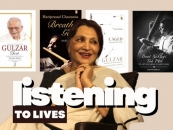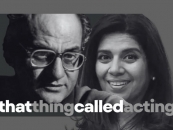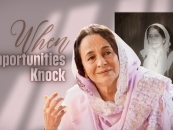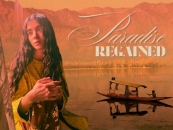-853X543.jpg)
His own terms: Sharad Raj
by Vinta Nanda January 25 2022, 12:00 am Estimated Reading Time: 13 mins, 54 secsEk Betuka Aadmi Ki Afrah Raatein is now streaming on Eventscape Vod Platform. Vinta Nanda has a chat with director Sharad Raj about his film and other things.
Ek Betuka Aadmi Ki Afrah Raatein – The Joyous Nights Of A Ridiculous Man, lingers on the alienation of a modern man in small town India. Set in 2013, in the towns of Muzaffarnagar and Lucknow in northern India, the film connects three different stories to observe the lives and times of its four dispossessed characters, at a time when communal forces are on the rise. Gulmohar is coming to terms with his self-obsessed existence in a post globalized, neo-liberal world.
Anita Muslim, a Bangladeshi immigrant and a commercial sex worker calls herself and her family the bookkeeper of communal violence in the Indian subcontinent, ever since partition. For Anita it is a responsibility she has inherited. And there is Gomti, the river and a young girl by the same name, in Lucknow.
From a family of shoemakers, Gomtis tryst with adulthood was getting over her foster father’s desires. Gomti wants to run away from it all. The father on the other hand takes refuge in changing social climate for the lower caste and the myth of Brahma and Saraswati to justify his lust. It is Gulmohar who binds the two stories of Anita and Gomti, while he also negotiates his own redemption.
Ek Betuke follows a non-linear, circular structure as the film goes back and forth in time. The film that merges three stories starts in a dream of the protagonist, Gulmohar. Most of the film is his dream, wherein he narrates his story, which is what actually happened to him and then ends in reality as he comes out of his reverie.
When Sharad Raj, the director of the film is asked by me why he decided to adapt three stories into a film, he tells me that cinema, in most parts of the world has historically been enslaved by older art forms like theatre and literature. Most filmmakers have struggled to bestow a uniquely cinematographic identity to cinema. He quotes Robert Bresson: “Cinema is writing with the camera.”
Hence, Sharad informs me, film directors world over have made great films as adaptations, because the unique identity of cinema can only be demonstrated if a purely cinematic work merges from a pre-existing text and literature. The skeptics will make notice of the fact that cinema despite being a confluence of several art forms can subsume all and emerge on its own. Therefore literary text provides that challenge to a filmmaker, he concludes.
I’m going, now, to my entire conversation with Sharad Raj, alumni of the Film and Television Institute of India (FTII) Pune, a teacher of cinema at the Whistling Woods International School of Cinema, as well as a filmmaker who says that he will only make films if it is on his own terms.
8.jpg)
Was making this film a challenge?
For me, personally, the challenge of giving the visual interpretation of the written word is both creatively demanding and aesthetically satisfying when an image emerges on screen that is stripped of all vestiges of literature and drama. This fundamentally is the basic struggle of every film artist, as much as it is mine.
How have you gone about giving a contemporary social context to the history here?
In order to have a good grasp of the story I was telling, an insight into the social and historical context that is an integral part of the film is needed. India was a British colony for hundreds of years before it got independent on August 15, 1947. This independence was result of the partition of the Indian subcontinent. The country was broken into two parts and Pakistan was created, which too was divided into two parts, i.e. East and West Pakistan.
With the intervention of India, East Pakistan got its independence and Bangladesh was formed as an independent country in 1971, after the Indo-Pak war. India. Therefore India has long communal history; in fact its independence itself was based on two-nation theory.
The partition saw the massacre of millions. Bangladesh, too, saw genocide in 1971, and since then divisive forces have made violence become a part of our political history. Hence according to me the rise of the right wing is just not an isolated incidence. It is a postcolonial manifestation that has slipped from being dogmatic socialism to becoming failed globalization. The film provides this historical context to its four principal characters, Gulmohar, Anita Muslim, Gomti and Gomtis father.
Muzaffarnagar and Lucknow are two towns of the largest north Indian state of India, Uttar Pradesh - the film is set there. Muzaffarnagar is the town that saw the bloodiest riots in the year 2013, just before the right wing government came into power in 2014. Lucknow is the capital of Uttar Pradesh and the seat of the government and since Uttar Pradesh sends the maximum number of Members of Parliament to the national Parliament, polarization helps extreme forces. Millions of citizens of Bangladesh migrated to India and settled down here, some legally and others illegally. One of the characters in the film is an immigrant from Bangladesh. Thus India’s postcolonial history is also its communal history and that forms the backdrop of the film.
Ek Betuka Aadmi Ki Afrah Raatein is a very personal response to contemporary India. Despite an overt political undercurrent, the film is primarily about people. How history, society and politics affect people and their lives with situations, which they have no control over. Film is also about love and its undying power to redeem lives from all circumstances.
8.jpg)
So then what was the aesthetic approach you adopted to make Ek Betuka Aadmi Ki Afrah Raatein?
At a broader level, the film follows an unified mise en scene, but also weaves a complex tapestry of film form at the same time, with influences and mediums coming together to tell a story cinematically. The biggest challenge, however, apart from converting the written text into cinema was to arrive at a balance of the political and the poetic.
While the political in the film refers to the collective unconscious, the poetic draws on the individual consciousness. Both the collective and the individual are in a dynamic relationship that feed of each other. Partition, war, riots and caste, are all elements that form a part of collective experience, while the alienation of the characters and them trying to make sense of what is happening to them, their dreams and nightmares, the poems they use are all deeply personal. The linkages are not direct but contextual.
Ek Betuke belongs to the rich tradition of ‘cinema of long take.’ Most of the scenes in the film are in single long take, one take-one scene approach, whether the scene is static or a moving, remains. The whole film therefore just had a 29-page script, as opposed to a classical narrative script that is usually of a 100 pages. Shot taking explores the idea of ‘ passing of time’ within a shot or a scene; hence the logic of the cut is temporal and not dramatic. It completely abandons plot that one is used to in dramatic films, on the contrary in Ek Betuke… my approach is to capture the essence of time as an observer, editing never comes into play to show a close-up or else a reaction, for artists are no one to intervene in the flow of time. This forms the aesthetic crux of the film.
At a micro level, the film mixes a whole lot of other mediums in the narrative as well; from documentary, to Internet, to advertising, newspaper cuttings etc. The film has a rather eclectic mounting en route to its search of truth, that is the basic goal of any work of art and artist.
Your use of music and dance in the film… can you tell me about it?
The principal source and inspiration of the background music is the cultural and geographical context of the story. It interweaves the sound and music with the visuals and the narrative. The music in my film is not composed, instead I’ve used pure ragas that move with the visual language of the film and therefore do not participate in the emotions of the narrative. It is a dialectical relationship of sorts I’ve attempted to achieve, where in the music and the film retain their respective identities but their coming together gives rise to a new emotion.
The dance in the film is used to represent the incestuous and erotic relationship of Brahma (The god of creation in Hindu Mythology) and Saraswati (the goddess of learning and Brahma’s daughter).
According to Hindu mythology, Brahma created the universe as a result of cohabiting with Saraswati. This in turn is the primal representation of the lust that the foster father in the film has for his adopted daughter, Gomti.
The dance draws from Kathak, yoga, physical theatre and Koodiattam to communicate sringar (erotic) in a slow sustained circular structure keeping in mind the myth. Dance becomes the non-verbal physicalization of the emotion, bringing out the churning of fleeting emotional states that occur through movement.
6.jpg)
So your film is streaming now. What are you feeling to know that your film is finally reaching worldwide audiences?
Am surprised and happy, it’s been quite a wait of close to three years since it premiered in Toulouse in 2019. The space for truly independent films is so very small that it is difficult to get them to be seen by a wider audience and the task becomes tougher if the film is dark and politically sensitive.
And you’ve adapted three short stories to make Betuke…?
Yes. Two stories of Dostoevsky - White Nights and Dream of a Ridiculous Man, and one of our very own Munshi Premchand, Bhoot. The 2013 riots form the background of modern day alienation and dehumanization.
I believe that your film has travelled to festivals already?
Yes it has. I must mention the festival director of Toulouse Indian Cinema Festival, Vanessa Bianchi, adores the film like no one else, Radim Spacek, a Czech filmmaker, had a wonderful Q&A after the Prague screening and that Sunny Gill of Toronto South Asian told me that the film is uniquely different.
When the streaming began Vanessa sent this message: To french viewers, I recommend this film presented at the Toulouse Indian Cinema Festival in 2019. An aesthetically rich first film, noble and humble at the same time, commuting between documentary and dreamy approach, between realism and theatrical, uncompromising and yet of great beauty. A must watch movie!
What was your process while making the film? A few interesting incidents/anecdotal memories would be nice to hear?
The film is partially crowd funded on Wishberry. There are a few moving memories of the process. First whomsoever I went to telling I was making a film but couldn’t pay for lack of funds, without batting an eyelid came on board at the story level itself. For me that was the power of cinema.
Then my two dear lieutenants, Vandana Kumar, who funded the trailer and then along with my brother in law, Labir Singh Bisht, worked tirelessly to raise funds. My wife told me that Labir would be on the phone all day since every morning and simply command his friends to contribute. Even Vandana has great social capital and big circles of friends - she tirelessly persuaded people to contribute. Then last but not the least came my producing partner Saleem Javed - when we ran out of funds he came on board as a partner with his hard earned contribution. I was left speechless. Why? There are no easy answers.
The commitment of the cast, Rajveer Verma’s tireless rehearsal sessions and watching movies that I would recommend for him to understand where I was coming from. Adil Hussain I remember saying to me, ‘I will come on board if either the money is good or the role’. I told him that I didn’t have a penny to offer but the role I could vouch for. The very first scene I shot with him at take 12 or 13 - I was tense because I had just heard of how stars can be moody. I walked up to him apologetically and he completely parlayed my fears. He said I could do many takes as I wanted and that it will never be an issue. He’s one of the finest people I have worked with apart from being a fine actor.
Archanna Gupta who plays Gomti told me on location in the marketplace that she would cry without glycerin and she just needed some time to do it. And boy! She broke down and I kept rolling the camera greedily for 10 minutes right until Arun Varma my cinematographer insisted I should call for cut. I ran up to Archanna and instead of waiting to be consoled by me, she asked, "apko mila jo chahiye tha?"
What commitment she gave to the film, and for getting nothing in return - neither pennies nor commercial release. Mia Maelzer, who plays the Bangladeshi sex worker, has a lot of body show and after watching her shot she said, "despite so much sex you have not objectified me”. What more can I ask as a filmmaker?
Arun Varma, my cinematographer, the only award the film has received till now is for cinematography, was amazing. During the recce, wherever we would stop for a meal, the first thing he would ensure was that food was available for me because I have diet restrictions. So much love was overwhelming; it transformed me to a great extent.
7.jpg)
When did it first occur to you that you want to be a filmmaker and why was it so important for you be one?
When I failed to qualify for medical entrance, I thought of converting my film viewing habit into a profession. I always felt a deep desire to express what I feel and think.
Where did you grow up? A few memories of your growing up years, about your family would be interesting to know.
I was born and brought up in Lucknow. Both my parents are doctors. We had a pampered upbringing; my father was a well-known psychiatrist, so all through the growing years, both my sister and I felt like the royalty of Lucknow.
I still remember Amitabh Bachchan’s dialogue from the film Lawaaris, "Hum jahan khadhe hotey hein line wahin se shuru hoti hai." Our friends and family would take pot shots at us. The biggest learning from my growing up days was the complete immersion in the ganga-jamuni syncretic culture of Lucknow – it’s no wonder that ending the communalism growing day-by-day in Uttar Pradesh is closest to my heart. Also, the exposure to Urdu poetry was huge. Our house had poets walking in and out of it, including the great Faiz. The idea of respecting the diversity of cultures India enjoyed was ingrained into us. We were taught how to do adaab the right way and so on...
What were your years in FTII like? What were they like - your batch mates and all?
They were the best years of my life. Everything I know about life and cinema happened there, from films to heartbreaks. My batch mates were a great group for sure.
You mentioned to me that you’re in the middle of making a film right now. Tell us a little about it?
Yes, it is being made as a part of my pursuit of making the films I want to make in the way that I see them. The film is called ‘Weekdays & Weekends’ and centers around two young couples and a middle-aged lady. It is largely taken from people I knew closely during my college days. It was heartening to know that my young cast could identify with all that is happening in the film even today.
You teach, you run a website Just Cinema, you make films and you’re a full-fledged Bombaywala. How does it all pan out for you?
Wonderfully. I simply want to spend the rest of my life watching, making, talking and discussing films. I really have no other interest and everything else that interests me from painting to literature to music to politics is only so that i keep myself nourished as a maker..






-173X130.jpg)

-173X130.jpg)
-173X130.jpg)

